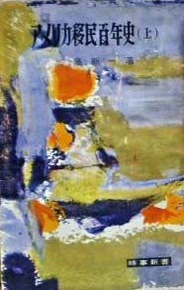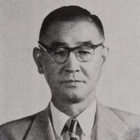If you search for "Kato Shinichi"
I learned that Shinichi Kato, who covered the footsteps of Japanese immigrants to the US mainland and compiled them into a book called "The Centennial History of Japanese Americans in the US," drove around the US alone, but the details of his journey were not clear in the afterword of the book. I wondered if there was anything else he had written. The first place I looked was the Internet.
When I searched for the name Shinichi Kato and related words such as "Centennial History," I found that he had written another book, "Centennial History of Immigrants in America," which consisted of three volumes. It was published in 1962, the year after the publication of "Centennial History," by Jiji Press as part of the Jiji Shinsho series.
This book, which has been out of print for a long time, is available in some large libraries and second-hand bookstores, but I decided to check out the actual book at the National Diet Library first. The content is almost the same as "Hyakunen-shi," but since it is published by a major Japanese publisher, it has been proofread and edited more thoroughly than "Hyakunen-shi," which was completed in a short time, making it easier for the general public to read.
The preface to the first volume describes the circumstances surrounding the publication of this new book. There are also some things that are not included in the afterword to "Centennial History." According to this, after the publication of the 1,500-page "Centennial History," "about 700 copies were donated to His Majesty the Emperor, His Imperial Highness the Crown Prince, central government agencies, prefectural governments, national and prefectural universities and their libraries, major city halls, chambers of commerce, and newspapers."
He continues:
"However, because it is a very large volume, expensive, and the number of copies is limited, it cannot be expected to be distributed to the general public. It would be a shame to limit this precious material on the overseas development of the Japanese people to only a limited portion like the above," thought President Saiji Hasegawa of Jiji Press and his publishing department, who decided to summarize the above-mentioned "100-Year History of Japanese Americans in America" and publish it as a popular edition, which is this book. Initially, they tried to summarize it into one volume, but they were afraid that shortening it too much would reduce the value of the publication, so Jiji Press made the bold decision to publish it in two parts, three volumes: an overview, "General History," and specific topics, "Development of Japanese Americans in Each State." It is clear that Jiji Press recognized the value of the "100-Year History."
Sent to America by his father
In his preface, Kato looks back with respect and pride on the difficult path that Japanese immigrants to America took, comparing it to his own life, and talks about the events that led to the compilation of his "Centennial History."
"Although they were called 'abandoned people,' and sometimes described as 'American Japs,' or that 'Japanese in America are two or three decades behind the times compared to people in the mainland,' the Japanese in America created a history spanning one hundred years, or a century.... However, after the war, there were almost no voices calling for reflection on this 'history.'
In 1916, when I had just entered middle school and was called over by my father and set foot on the American mainland, Japanese living in America had already moved from the age of laborers to the age of farming and business management. In the midst of the frontier era of early American westward development, the first generation of pioneers endured unspeakable hardships and overcame continuing anti-Japanese sentiment.... We, who were called the "call-over youth," also experienced anti-Japanese sentiment on a daily basis, to a greater or lesser extent."
I thought anti-Japanese sentiment would get worse after the war...
The Japanese overcame these hardships, and the second generation were able to own land, and development was expected. But then war broke out between Japan and the United States, and they were forced to move out, and suffered further tragedy. So what path did Kato himself take?
"At the time the war broke out, I was the editor-in-chief of the American Industrial Daily in Los Angeles, and was immediately interned. In the summer of 1942, I returned to the United States on the first exchange ship, and experienced life as a journalist in the mainland during the most difficult period of the war and the postwar period. In 1953, I returned to the United States, where I remain to this day. One of my motives for returning to the United States was that, having experienced the exclusion I had experienced before the war, I thought that anti-Japanese sentiment would only get worse after the war. However, when I returned to the United States after more than ten years in Japan, I found that this judgment was 100% wrong. Sentiments toward Japan and Japanese people in the United States showed the greatest improvement in recorded history, and the Japanese people living in the United States The American people had recovered from the adversity they faced during and after the war, and were at a new stage of development, even more so than before the war. They were no longer immigrants or abandoned people, but had taken root on American soil as "American citizens" (most of the first generation had become naturalized American citizens). Whereas before the war they were confined to the western part of the country, the wartime climate had been a blessing and they had blended into American society across the country. I was amazed to see that Japanese tastes were permeating all aspects of American society, to the point that it was called the Japanese style boom, in keeping with the words of a great philosopher who said, "War is the greatest cultural exchange."
Kato's experience of seeing the development of Japanese people in America has once again strengthened his respect and gratitude for the pioneers known as the Issei. He concludes, "It was a kind of sense of mission as a member of the newspaper business that led me to push myself, even at the age of over 60, to edit 'The Centennial History of Japanese Americans in America.'"
10 months, 80,000 km journey
As in the afterword to the "Centennial History," the book briefly touches on the reporting on the mainland as follows:
"He says he was 'tired,' but I had set off from California, driven solo for 10 months and 80,000 kilometers by car, traveling across the country through scorching heat of about 100 degrees Fahrenheit and snow in temperatures of about minus 10 degrees, before returning to Los Angeles, and I think I did quite well to see it through..." he recalled.
In the afterword, the trip was said to have lasted "nine months and 40,000 miles (64,000 km)," but perhaps after recalculation it was actually "ten months and 80,000 km." In any case, no further details about the trip were given.
(Titles omitted)
© 2020 Ryusuke Kawai







